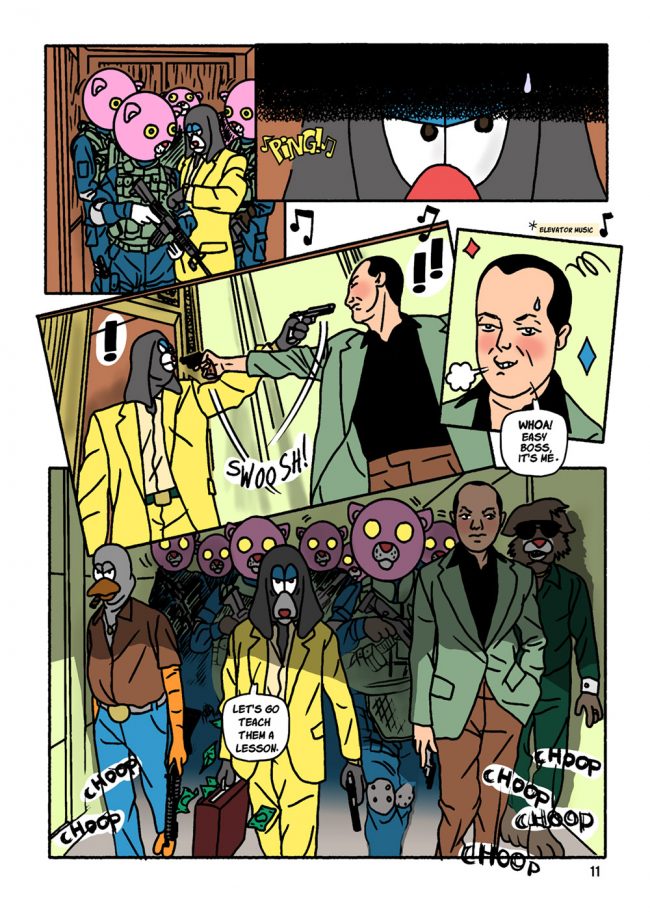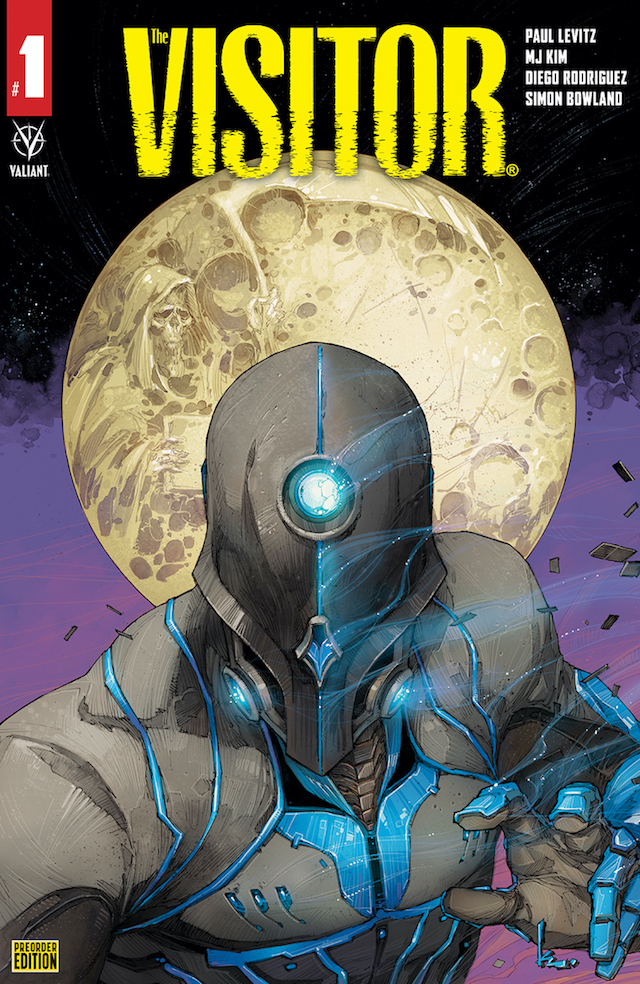The title of this slim but powerful volume is a bit of misdirection on the part of its author. It refers to his unnamed protagonist, a light-skinned black man with a sculptural pompadour who functions as a stand-in for creator E.S Glenn himself. The character, an aspiring artist turned petty criminal, abets his ringleader on a series of heists, joined by a motley crew of toughs reminiscent of Bodhi’s gang in Point Break, or the masked bank robbers in Spike Lee’s Clockers. But although the character struggles with self-doubt and low self esteem, the book is anything but unsmooth.
It is a complex meditation on masculinity, race, class, the art world and the act of cartooning, dressed up to look like a stylish thriller, and drawn with heaps of confidence and skill. Aesthetically, the book is a compelling mash-up of European and American motifs: Glenn, an American expat living in Berlin, has been heavily influenced by European cartoonists like Herge, Joost Swarte, Muñoz & Sampayo and Baptiste Virot, although the artist he most clearly evokes in these pages is Daniel Torres, right down to the snappy wardrobe design. But the environments in which his small-time hustlers ply their trade are distinctly American, studded with pawn shops and palm trees.
My only quibble with the artwork-and this should be taken with a grain of salt because I’m old-is that there are moments when the digital drawing becomes very obviously digital. There are small moments where the line peters out, or the coloring is blurred in a way that cuts through my suspension of disbelief and reminds me that I’m looking at work created on a tablet. Being the Luddite that I am, I found these moments slightly jarring. That said, Glenn’s clear-line style is charming and technically impressive enough to make up for these moments, and they did not detract from my overall enjoyment of the work.
 The book, published by Floating World Comics, is a series of vignettes, which, when read sequentially, form the character study of a young man who, after losing his mother as a teenager, has struggled to support himself as a painter throughout his adult life. In “A Life of Crime for Me”, he muses, in a series of captions set over a violent armed stand-off:
The book, published by Floating World Comics, is a series of vignettes, which, when read sequentially, form the character study of a young man who, after losing his mother as a teenager, has struggled to support himself as a painter throughout his adult life. In “A Life of Crime for Me”, he muses, in a series of captions set over a violent armed stand-off:
“At first, whenever I blundered at my attempts to prosper, I thought it was a test. ‘Thought it was the universes [sic] way of teaching me how to look out for failure...But ultimately, after much trial and error, I understood that some people are not meant to surpass a certain level. Not supposed to climb as high as they would like to. Some of us get slowed down from the outside...I try to reach this fabricated threshold of intellectual prowess, only to end up overwhelmed and in way over my head.”
This monologue, which continues for pages, is an indictment of the American “pull yourself up by your bootstraps” ethos that ignores the racist atrocities perpetrated against African-Americans and disingenuously assumes a level economic playing field, but it’s also a tender and very honest unpacking of one individual’s interior life, an examination of the defense mechanisms we create in the wake of trauma. E.V Glenn’s avatar exists in the legacy of stylish and loveable “bad” men, but the work is idiosyncratic in ways that set him apart.
 Throughout the book, the character’s ambivalence towards the art world is highlighted again and again, recalling the mischievous satire of the artist Jayson Musson, aka Hennessy Youngman, whose series of “Art Thoughtz” videos on Youtube purported to teach the viewer about contemporary practices, all the while sending up the exclusivity of art institutions. And honestly, is there a better medium than comics for an artist frustrated by art-world snobbery? What better antidote to $120,000 bananas than art that’s cheap to make and easily disseminated? What better way to stick it to the rich gatekeepers than to make a comic full of beautiful art and transgressive ideas that anyone can walk into a shop and purchase for a few bucks? The story “Traveler” in which Glenn’s avatar is dropped into a comic strip, is a playful, fourth-wall-breaking investigation of the medium, in the spirit of Ernie Bushmiller’s Nancy. After using some complex electronic equipment to determine that he is, indeed, trapped in a comic strip, the character announces “I am not where I need to be….Alas, I will now attach my temporal sequencing cables and make my way back home.” It’s clear from this beautiful book that Glenn, like so many other bright but disenfranchised weirdos, has found a home in comics. I can’t wait to see what he makes next.
Throughout the book, the character’s ambivalence towards the art world is highlighted again and again, recalling the mischievous satire of the artist Jayson Musson, aka Hennessy Youngman, whose series of “Art Thoughtz” videos on Youtube purported to teach the viewer about contemporary practices, all the while sending up the exclusivity of art institutions. And honestly, is there a better medium than comics for an artist frustrated by art-world snobbery? What better antidote to $120,000 bananas than art that’s cheap to make and easily disseminated? What better way to stick it to the rich gatekeepers than to make a comic full of beautiful art and transgressive ideas that anyone can walk into a shop and purchase for a few bucks? The story “Traveler” in which Glenn’s avatar is dropped into a comic strip, is a playful, fourth-wall-breaking investigation of the medium, in the spirit of Ernie Bushmiller’s Nancy. After using some complex electronic equipment to determine that he is, indeed, trapped in a comic strip, the character announces “I am not where I need to be….Alas, I will now attach my temporal sequencing cables and make my way back home.” It’s clear from this beautiful book that Glenn, like so many other bright but disenfranchised weirdos, has found a home in comics. I can’t wait to see what he makes next.







